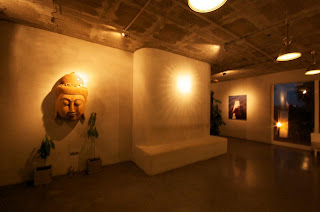Japanese design uses simple lines and pale colours to create a calm space. Traditional Japanese homes use Shoji screens (wood framed screens with rice paper inserts) to separate spaces, and still allow light to flow from one room to another.
 |
| The window panels mimic the look of traditional Shoji screens. |
Chinese design very different from Japanese style. The interiors are known for their red and black interiors, and furnishings are used as showpieces. Chinese culture is rich in tradition and superstition. Red symbolizes happiness and good luck which is why it's used liberally in interior design.
 |
| Red is the symbol of luck and happiness. |
Vietnamese and Indonesian style is influenced by the tropical climate, but maintains the Asian feel.
More and more, western culture is embracing the elements of Asian design. When I think of Contemporary Asian design, I think of Zen, or Feng Shui, but what does that really mean?
 |
| The walkway at the Cactus Club Cafe in Abbotsford, BC is inspired by Asian design. |
 |
Feng Shui is the placement of a building and the placement of objects inside a building to optimize the flow of Qi (pronounced "chee"). Qi is energy, or life force. By optimizing the flow of energy in your surroundings, you create harmony between you and your environment to improve your overall health, wealth and relationships. Feng Shui typically uses horizontal lines which are calming, whereas, vertical lines are very dynamic.
Surprisingly, Donald Trump is a well known Feng Shui user. After losing many Asian clients due to the "bad" Feng Shui in Trump Towers, he hired a Feng Shui master, Pun-Yin, to reorganize his offices. Her video on Fox news describes how you can customize a location to your specific needs, using natural materials such as wood, water, and plants.
 |
| "The Donald" |
 |
| The Lobby at Trump Tower Chicago |
Contemporary Asian Design uses natural materials to add to the calming feel. Whether you believe in the powers of Feng Shui or not, there are some basic principles that are just plain common sense. For example...
1. Clear clutter. Only keep objects that you need or you love. Clearing visual clutter helps calm your mind.
2. Surround yourself with beautiful things regardless of it's monetary worth. If you have photos, or objects that remind you of happy memories, display them. This is an easy way to boost your happiness as well. Vice versa, if something triggers bad or sad memories, or if you just don't like something, give it away.
William Morris, influential designer from the early 20th century once said, "Have nothing in your houses that you do not know to be useful, or believe to be beautiful".
3. Bring in air and light. In Feng Shui, this prepares a space to receive good energy, but having fresh air in your home is healthier for you, regardless of it's Feng Shui appeal. Studies have shown that the air in a home is often more polluted than the outside air. Adding bamboo is an easy way to help cleanse the air, but using an air filtration system is also a great idea. As for light, we all know the best way to get Vitamin D, which helps improve happiness, is from sunlight, so open up the curtains and let the sun shine in.
 |
| This home uses a neutral colour scheme and adds a "lucky red" accent wall for interest. |
It's not hard to see why Asian design elements are influencing western design more and more. Contemporary Asian design is well thought out to create a space that is calming. At the end of a busy day, your home should be a sanctuary and a contemporary home is the perfect place to wind down and relax.
Links:
https://blogger.googleusercontent.com/img/b/R29vZ2xl/AVvXsEiVva52GQG28rjdFGXgFhCcLO2WDt1Ntmp1-sGxnrugVewJYkQbMLHQkyv_4Z2EmMGwkHr6LN5MoDHybYWexTw3sPvPMpuyS5-pgwfAZdwZDD-waAzxijdRiY4zBl6J-ixLt2AahcefNhQZ/s400/Home+Interior+Design+Ideas+Japanese+Interior+Design++15.jpg
http://bs2h.com/modern-chinese-interior-design/classic-modern-chinese-interior-design/
http://wiki.answers.com/Q/What_does_red_symbolize_for_Chinese_culture
http://upload.spottedbylocals.com/Berlin/normal/yoga-school-berlin-berlin-(by-yoga-school-berlin).jpg
http://www.white-ibiza.com/wp-content/uploads/8029546517_a93e4a3a53_z.jpg
http://www.healthclubandspa.com/images/slider/zen-yoga-room.jpg
http://www.elephantjournal.com/2012/03/top-10-feng-shui-myths-debunked/
http://en.wikiquote.org/wiki/William_Morris
http://www.commonsensehome.com/practical-feng-shui/
http://www.actonostry.ca/news/ccab-opening/


This comment has been removed by the author.
ReplyDeleteGreat information you have shared here, through this post. Thanks and keep sharing such valuable updates through your side. best interior designers in odisha
ReplyDelete